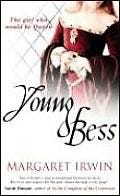Young Bess is about the future Queen Elizabeth I from shortly before the death of her father, Henry VIII, when she was twelve, until the death of Henry's successor, her younger half-brother Edward VI, when she was nineteen.
This was an extraordinary period in Elizabeth's extraordinary life. After her father's death, she lived with her stepmother, his sixth and surviving queen, Catherine Parr, and Thomas Seymour, the dashing, ambitious and reckless man Catherine married less than three months after Henry's death. Seymour had floated the idea of marrying Elizabeth before he wedded Catherine, and the historical record makes clear that he played teasing, erotically-charged games with the young teenager. These would lead to his execution and place Elizabeth herself in grave danger. Elizabeth's feelings about him, which Irwin portrays with rich psychological insight, are the centerpiece of the novel.
Elizabeth's personal life could never be disentangled from affairs of state. Laced with Irwin's ironic wit, Young Bess focuses as much on the political maneuvering and upheavals of Edward VI's reign as on Elizabeth's personal fears and yearnings. The battles among the boy-king's regents were set up as the dying Henry prepared his will. “Edward Seymour, as Prince Edward's uncle, would be on the council of Regency which Henry appointed… And he added Edward Seymour's younger brother Tom to the council, a lively fellow after his own kidney, with none of Edward's priggish and possibly dangerous earnestness;--he might act as a check on it, for the two brothers couldn't abide each other.”
Because much of the first two chapters are devoted to filling the reader in on significant events of Henry's reign, the story doesn't feel fully launched until Chapter 3. But Irwin tells the backstory with her typical astute wit, so readers interested in the history of the Tudors will not greatly mind the delay. (originally published in 1944, reissued in 2007; 393 pages)




